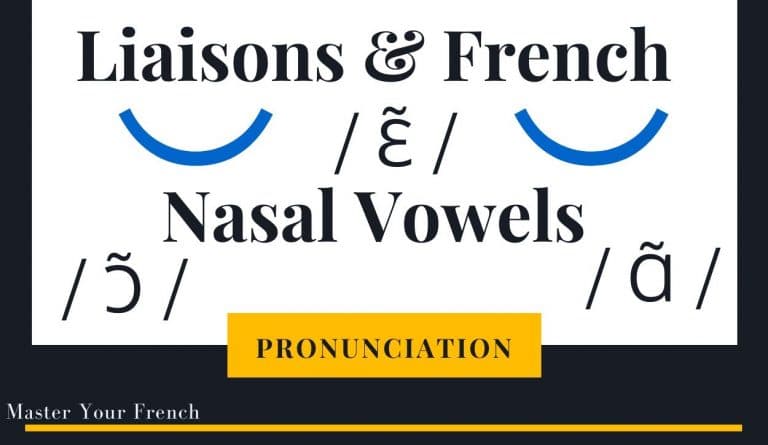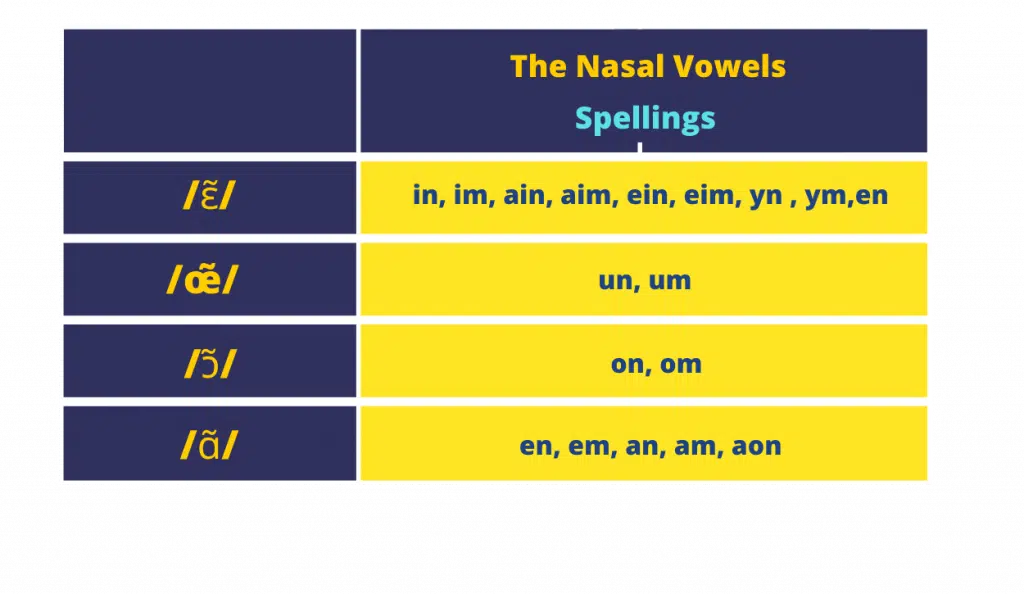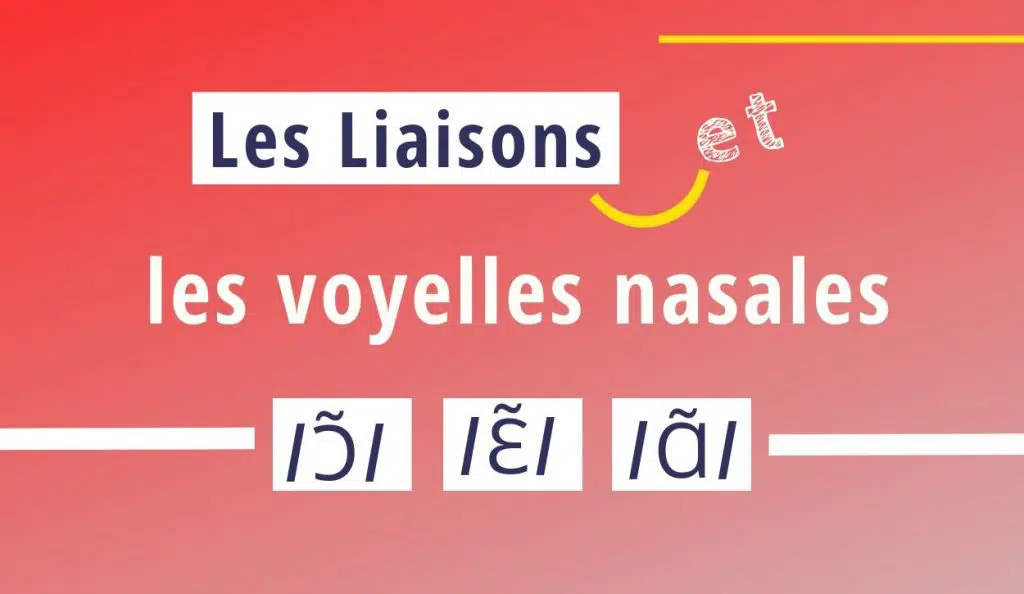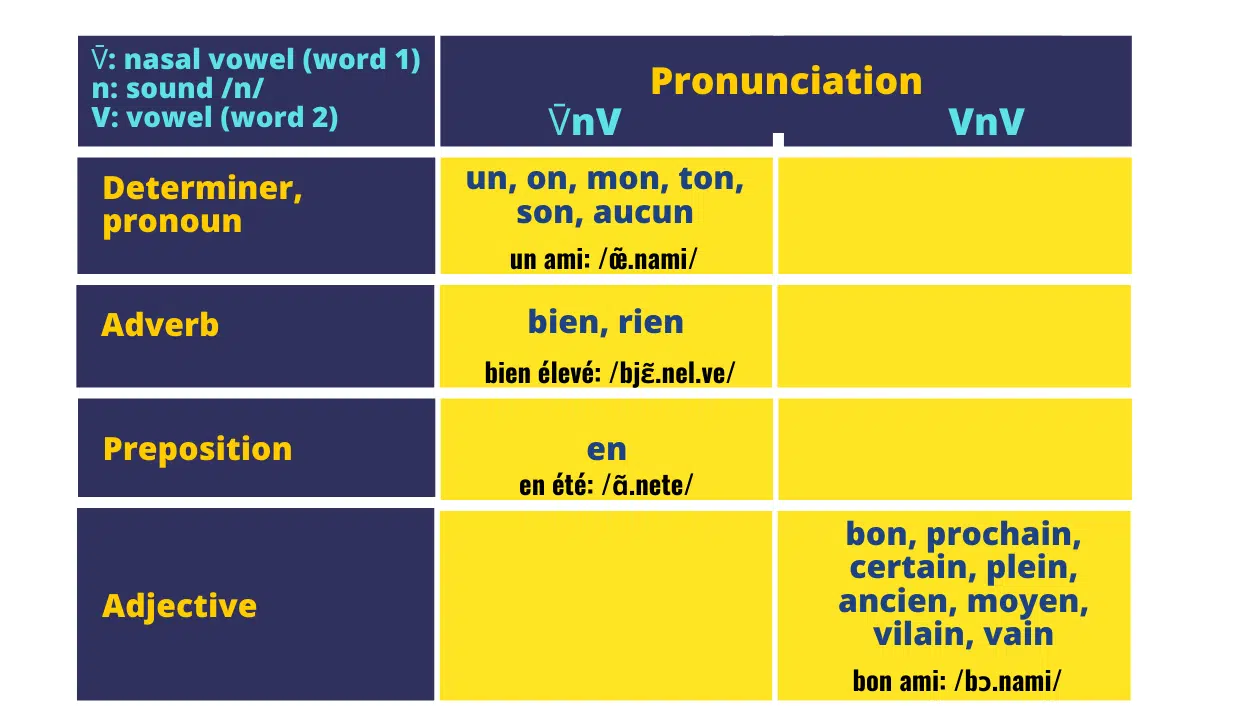French nasal vowels in liaisons
Updated: 21 November, 2023 by Mylene in Pronunciation Lessons ▪

In this article, we’ll focus on the liaison between a French nasal vowel and the vowel of the following word. You’ll learn whether the full nasal quality of a nasal vowel is maintained in a liaison context or whether the vowels are denasalized.
In this post, you’ll learn:
- What is a liaison in French?
- What is a nasal vowel in French?
- Liaison and French nasal vowels (a video)
- When liaisons must be made?
- Denasalization with liaison in French
- French prononciation chart
What is a liaison in the French language?
A liaison in the French language is the pronunciation of a consonant sound between two given words, under certain conditions. The conditions for the appearance of a liaison are the following:
- The first word ends with a silent consonant
- The second word must begin with a vowel or a silent h
- There is no pause between the two words
Examples of liaisons in French
Do we pronounce the “-t” in “petit pain”?
Petit pain: The final consonant –t of the masculine, singular adjective, petit (small) is silent. It is not pronounced. In French, “petit pain” is pronounced /pə.ti.pɛ̃/.
Do we pronounce the “-t” in “petit ami”?
Petit ami: In this case, “petit ami” is pronounced /pə.ti.ta.mi/. The letter –t is pronounced when the adjective is followed by the vowel -a that is in the singular noun ami. We make the liaison, the consonant -t becomes part of the syllable at the beginning of the word ami that follows.
What Is A Nasal Vowel In The French Language?
In French, there are 4 nasal vowels:
- /ɛ̃/
- /œ̃/
- /ɔ̃/
- /ɑ̃/
In most of the regions in France, /œ̃/ has disappeared, it’s pronounced /ɛ̃/ instead.
To learn more about nasal vowels, as well as French sounds, go check our article on International Phonetic Alphabet for French.
How to pronounce the nasal vowels in French?
How to spell the nasal vowels in French?
The table below presents how to read and write nasal vowels in French.

Similarly, here’s an article that covers the spelling of oral vowel sounds in French.
Liaison and French nasal vowels (A video)
Check the video below where I show you how to explain in detail the pronunciation of the French nasal vowels in liaisons.
Watch this video to learn how to pronounce French nasal vowels in liaisons. To follow more updates, subscribe to the YouTube channel and follow me on Instagram.
To learn more about liaisons in French, I published another article about Mandatory Liaisons in French.
Conditions in which liaisons must be made
In the following, I’ll list the conditions in which a liaison must be made and others in which it must not. Some liaisons are pronounced except sometimes in familiar speech.
How to pronounce French nasal vowels in liaisons?
The liaison is pronounced as follows:
nasal vowel + /n/ sound + vowel
For example, un ami is pronounced like /œ̃.na.mi/
1. Determiner + Noun
The liaison is required with:
- un: un ami is pronounced like /œ̃.na.mi/ ( a friend)
- mon: mon oiseau is pronounced like /mɔ̃.nwa.zo/ (my bird)
- ton: ton invité is pronounced like /tɔ̃.nɛ̃.vi.te/ (your guest)
- son: son arbre is pronounced like /sɔ̃.naʁbʁ/ (his tree)
- aucun: aucun appel is pronounced like /o.kœ̃.na.pɛl/ (no call)
There are some exceptions:
- un as pronoun: the liaison is forbidden. For example:
- J’en veux un // avant de partir. (I want to have one before I left)
- aucun as pronoun: the liaison is forbidden. For example:
- Je n’en vois aucun // ici. (I see none of them here)
- after quelqu’un, there is no liaison. For example:
- quelqu’un // a téléphoné (someone called)
- quelqu’un // a dit (someone said)
2. Liaison after bien
After a monosyllabic adverb, the liaison is usually pronounced. For example:
- bien entendu is pronounced like /bjɛ̃.nɑ̃.tɑ̃.dy/ (of course)
- bien élevé is pronounced like /bjɛ̃.nel.ve/ (well mannered)
In the following sentences, the liaison is prohibited. In other words, bien doesn’t change the pronunciation in what follows.
- On vit bien // ici is pronounced /ɔ̃.vi.bjɛ̃.i.si/ (We live well here)
- Est-ce bien ou mal? is pronounced /ɛs.bjɛ̃.u.mal/ (Is it good or wrong?)
3. Liaison after rien
With the word rien, the liaison in French is made as follows:
- rien + past participle or before à + infinitive
- Rien entendu is pronounced /ʁjɛ̃.nɑ̃.tɑ̃.dy/ (nothing heard)
- Rien à dire is pronounced /ʁjɛ̃.na.diʁ/ (nothing to say)
Otherwise, there is no liaison. For example:
- Il veux rien // en or is pronounced /il.vø.ʁjɛ̃.ɑ̃.nɔʁ/ (he wants nothing in gold)
4. The pronoun on
In French, the pronoun on always links:
- With the verb that it follows and of which it is the subject. For example: on a chaud is pronounced like /ɔ̃.na.ʃo/ (We are hot)
- Or with the object pronouns. For instance, on y va is pronounced /ɔ̃.ni.va/ (we’re going)
The liaison is forbidden between the inverted pronoun subject on and any following element. Here is one example where the liaison should not be made with on:
- Pense-t-on // aux imprévus ? is pronounced /pɑ̃s.tɔ̃.o.zɛ̃.pʁe.vy/ (Do we think about unforeseen events?)
5. The preposition en
The liaison is required after the monosyllabic preposition en. Here are two examples:
- en Italie is pronounced /ɑ̃.ni.ta.li/ (in Italy)
- en avance is pronounced /ɑ̃.na.vɑ̃s/ (in advance)
Note that the liaison is not pronounced between the inverted pronoun en and any following element.
For instance: Prends-en //un is pronounced /pʁɑ̃.zɑ̃.œ̃/ (take one).

Have you ever wondered how to pronounce the letter S between two vowels? In French, the letter S has 2 pronunciations in the middle of a word: [s] vs. [z]. Check this article to learn when to pronounce S in french and when the S sounds like Z.
Denasalization with Liaison in Standard French
The liaison is compulsory, even in conversational usage, in the following case: adjective + noun.
Adjective ending with a nasal vowel
The word-final nasal vowel should not be followed by a silent consonant in the spelling of the word. For example, the word “temps” has three silent letters at the end: m,p, and s.
- The liaison will be possible with the letter “s” and not with the nasal consonant “m”.
The cases of denasalization with liaison are related to a limited number of adjectives ending in /ɛ̃/ and /ɔ̃/.
Note regarding feminine forms
It is important to note that it is the masculine singular forms here that are of interest, as the feminine forms of these adjectives all end in pronounced, fixed nasal consonants whether before a following vowel or a consonant. For example:
- The feminine adjective “bonne” is pronounced /bɔn/
And that’s why there is no liaison.
Pronunciation
The nasal vowel of the adjective is no more pronounced. Instead, you have to pronounce an oral vowel.
The liaison is pronounced as follows:
oral vowel + /n/ sound + vowel
bon ami is pronounced like /bɔ.na.mi/
You must always pay attention to the syllabic division. The consonant added and pronounced during a liaison must always be pronounced with the vowel of the following word. In the case of “bon ami”, it is necessary to pronounce the syllable “na”.
Also note that when performing denasalization, you will pronounce an open vowel such as /ɛ/ or /ɔ/.
Examples
Here are some examples:
- un bon ami is pronounced like /œ̃.bɔ.na.mi/ (good friend)
- en plein air is pronounced like /ɑ̃.plɛ.nɛʁ/ (open-air)
- un certain âge is pronounced like /œ̃.sɛʁ.tɛ.naʒ/ (certain age)
- le prochain hôtel is pronounced like /lə.pʁɔ.ʃɛ.no.tɛl/ (the next hotel)
- le plein emploi is pronounced like /lə.plɛ.nɑ̃.plwa/ (full employment)
- le Moyen Âge is pronounced like /lə.mwa.jɛ.naƷ/ (the Middle Ages)
- le divin enfant is pronounced like /lə.di.vi.nɑ̃.fɑ̃/ (divine child)
French prononciation chart: liaisons and nasal vowels

Notes
Fixed expression in French
D’un commun accord is always pronounced /dœ̃.kɔ.mœ̃.na.kɔʁ/.
Phonetic difference
In some cases, there is phonetically no difference between the masculine and the feminine. They have exactly the same pronunciation.
- quelle bonne élève (feminine) or quel bon élève (masculine) are both pronounced /kɛl.bɔ.nel.ɛv/
- l’ancienne amie (feminine) or l’ancien ami (masculine) are both pronounced /lɑ̃.sjɛ̃.na.mi/.
Beyond Liaisons in French
Master Your French blog covers a wide range of topics related to French pronunciation, listening, culture, and much more.
If you enjoyed the content of this article, keep learning French with Master Your French by subscribing to our YouTube channel.



Very simple and understandable! Thank you.
Hello John! Thank you for the comment. A très bientôt!